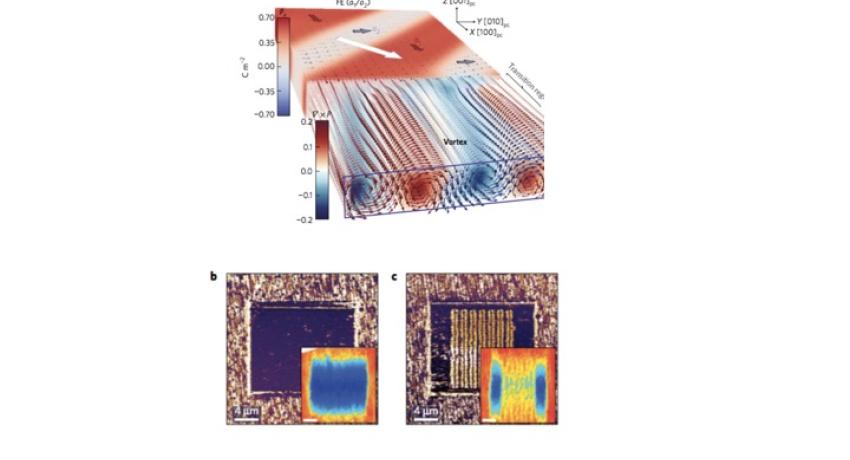(top) A zoom-in of the phase-field calculation focusing on a single PbTiO3 in a PbTiO3/SrTiO3 superlattice revealing that the ferroelectric a1/a2 superdomain smoothly transitions to the vortex phase comprising of alternating clockwise and anticlockwise polarization vortices. (below, left) a window of Vortex region written electrically in a matrix of mixed phase, and (right) striped of mixed phase within the vortex window.
Systems that exhibit phase competition, order parameter coexistence, and emergent order parameter topologies constitute a major part of modern condensed-matter physics. Here, by applying a range of characterization techniques, and simulations, we observe that in PbTiO3/SrTiO3 superlattices all of these effects can be found. By exploring superlattice period-, temperature- and field-dependent evolution of these structures, we observe several new features. First, it is possible to engineer phase coexistence mediated by a first-order phase transition between an emergent, low-temperature vortex phase with electric toroidal order and a high-temperature ferroelectric a1/a2 phase. At room temperature, the coexisting vortex and ferroelectric phases (Figure) form a mesoscale, fiber-textured hierarchical superstructure. The vortex phase possesses an axial polarization, set by the net polarization of the surrounding ferroelectric domains, such that it possesses a multi-order-parameter state and belongs to a class of gyrotropic electrotoroidal compounds. Finally, application of electric fields to this mixed-phase system permits interconversion between the vortex and the ferroelectric phases (Figure) concomitant with order-of-magnitude changes in piezoelectric and nonlinear optical responses. Our findings suggest new cross-coupled functionalities.
Nature Materials 16:1003 (2017) DOI: 10.1038/NMAT4951
Credits/Names: Penn State NSF-MRSEC DMR-1420620, DMR- 1210588, DGE-1106400, DOE Grant Number, DE-SC0012375, DE-AC02-05CH11231, DE-SC0008807, FG02-07ER46417 , DE-AC02-05CH11231, DE-AC02-06CH11357, DE-AC02-05CH11231, ARO grant W911NF-14-1-0104, Moore foundation GBMF5307, A. R. Damodaran,1 L.-Q. Chen,2 D. D. Fong,3 R. Ramesh,1 L. W. Martin,1 et. al. , 1U. C. Berkeley, 2Pennsylvania State University, 3Argonne National Laboratory.
Download PDF Version: IRG1 Electric-Field Control - 2018.pdf
Year of Highlight: 2019
IRG: IRG1 - Layered Ferroics


